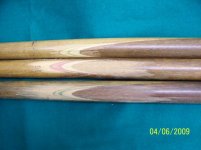I dont quite understand what the exact definition of butterfly conversion cue means? Can anyone answer this?
You are using an out of date browser. It may not display this or other websites correctly.
You should upgrade or use an alternative browser.
You should upgrade or use an alternative browser.
What exactly is a butterfly conversion cue?
- Thread starter joemuffler
- Start date
a full butterfly spliced cue witch is converted into another cue? Im guessing.
so a cuemaker took someone elses cue and made it a cue again?
so a cuemaker took someone elses cue and made it a cue again?
here is one for you. I think he make his own splice.
http://forums.azbilliards.com/showthread.php?t=192980
asiasdad
Banned
so a cuemaker took someone elses cue and made it a cue again?
That is the general description of "a conversion cue".
Most normally associated with various Brunswick one piece house cues
of the day. The most common being a Titlist conversion.
In the case of a butterfly conversion, here's a thread
of a Brunswick Hi-Run full splice butterfly from back in
the 50's that I obtained from my friend Ken:
http://forums.azbilliards.com/showthread.php?t=121983
So if a cuemaker takes one of these butterfly cues and converts it, then does he sign it and say its his?
asiasdad
Banned
So if a cuemaker takes one of these butterfly cues and converts it, then does he sign it and say its his?
In my experience, most of the conversion cues that are signed by
the one doing the conversion have been disclosed up front as being
just that: a conversion cue.
My friend Craig (MANWON) on this forum had to be talked into signing
his name on a Titlist conversion he did for me a few years ago,
and the butterfly conversion cue in my possession at this time was
not signed at all, however it was fully disclosed as a conversion cue
from owner to owner.
Richard Black. He signed the work after taking a one piece Brunswick butterfly cue and making it a two piece.
Ivory joint and Hoppe ring. The cue is retapered and rebalanced. Black also matched two shafts.
He didn't make the cue...he made it better.This one is available for sale or trade unchalked since 2005.
Inquirries by PM are welcome. The pics will say the rest



Ivory joint and Hoppe ring. The cue is retapered and rebalanced. Black also matched two shafts.
He didn't make the cue...he made it better.This one is available for sale or trade unchalked since 2005.
Inquirries by PM are welcome. The pics will say the rest



Last edited:
Here is one that I recently completed for a customer, I have been signing all my conversions for around two years now, before that I did not sign them unless asked to do so. I gave this a great deal of thought and I decided that since at least my conversions are nothing like what they were it is no different than buying a blank and making a cue out of it which all most all cue makers do. I kinda think the biggest factor to be considered is full disclosure of what I am selling. Unlike others I do not convert a cue and then sell it as unidentified cue, and I never claim I made something if I didn't. The biggest advantage to conversion of old one piece house cues is the age of the wood and the stability of the wood. The cues I like to convert were made before 1930, and I like these for two reasons first, the wood is most likely around 100 years old, and second the diameter of these cues is larger than those made later which gives you more to work with.
The cue below was converted from a 1920's Brunswick one piece Butterfly cue. The cue was cored half way up in to the handle
to properly balance the cue. The rings were made from Backgammon board pieces also from the 1920's and the shaft on this cue was turned in shop over a year and half period of time. This cue is kinda unique for many reasons and if you look at the photo's is is signed.
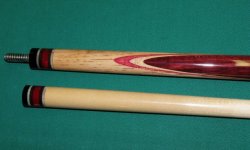
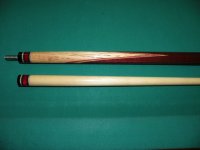
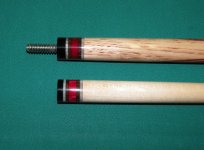

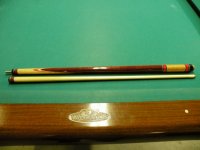
Hope this helps
The cue below was converted from a 1920's Brunswick one piece Butterfly cue. The cue was cored half way up in to the handle
to properly balance the cue. The rings were made from Backgammon board pieces also from the 1920's and the shaft on this cue was turned in shop over a year and half period of time. This cue is kinda unique for many reasons and if you look at the photo's is is signed.





Hope this helps
Good Info. Thanks much.
